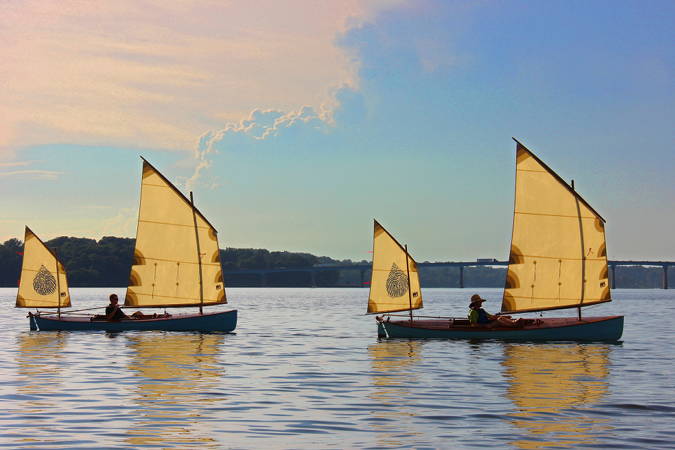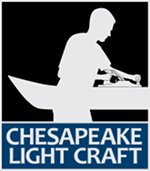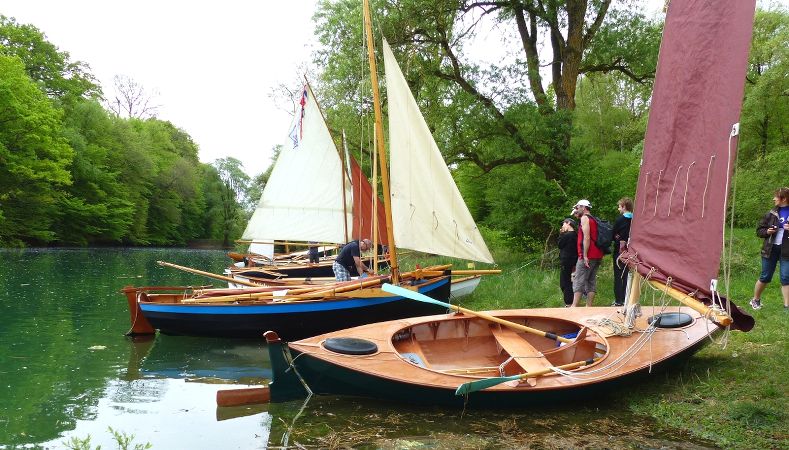










































Product Description
The Waterlust sailing canoe brings innovative features to a classic well-proven design to make a very capable expedition boat. The boat is easy to handle with the traditional yawl rig and integrates a pedal drive for backup power.
Designed by Dillon Majoros of Chesapeake Light Craft, in conjunction with the film-making team Waterlust, the first two of these sailing canoes have already proven themselves on a 1000-mile coastal expedition down the Intracoastal Waterway of the USA.
The design is inspired by classic sailing canoes of the late 19th century, but Dillon has added a higher volume hull with fuller ends for increased carrying capacity, stability and performance under sail. The hull design includes watertight compartments fore and aft, watertight storage forward of the cockpit and stowage bins port and starboard in the cockpit that double as support rails for the seat. The cockpit extends under the aft deck and may be used as a berth for the crew. The boat is powered by a yawl rig, which is traditional to the type and easy to manage too.
Among the more unusual features of the design is an integrated Hobie Mirage Drive for auxiliary power. This drops into a case in the cockpit.
In July 2016 a matched pair of these 17-foot sailing canoes were built, finished and rigged in a marathon three weeks. Then the Waterlust crew set off for Miami, cameras rolling. The long coastal trip was a perfect trial for the new design. They minded the weather, as sailing canoe voyagers do, including the menacing Hurricane Hermine, but encountered few issues during the trip.
The elegantly proportioned design has generated much enthusiasm from fans of small boats. Expedition-worthy sailing canoe designs have existed for at least 150 years, but the features worked into this new design broaden its appeal. The Hobie Mirage Drive, in particular, is a remarkable feature. GPS speeds over six knots were recorded using the pedal drive alone. But perhaps the best thing about it is the ergonomic arrangement of the cockpit, making ‘motorsailing’ with the Mirage Drive as natural as walking. For pure sailing, the Mirage Drive can be lifted out of its watertight case and stowed in the cockpit.
It is even possible for a single adult to sleep in the cockpit.
The Waterlust sailing canoe is technically a cat-ketch, though in spirit it is a cat-yawl. The mainsail provides most of the drive while the mizzen adds balance and offwind power. Those living in windy conditions may opt to set the main mast a bit further back and eliminate the mizzen. The boats are fast and close-winded under sail. Stability is surprisingly solid, though as in any sailing canoe you won't want to cleat the mainsheet!
The boat has a clinker-style plywood hull using CLC's patented LapStitch™ stitch-and-glue technique, which produces a beautiful boat with maximum strength and minimum weight.
Computer-cut marine plywood panels are stitched together to form the hull in a matter of hours. The daggerboard case and pedal-drive case sub-assemblies are built separately and then installed in the hull with epoxy fillets. Plenty of reinforcement with fibreglass fabric and saturating coats of epoxy yields a stiff, rugged hull that weighs only about 36 kg (80 lb). Fully rigged, the Waterlust sailing canoe weighs about 52 kg (115 lb).
In early 2020, three novice boat builders – in the UK, USA and Norway – set out to build their Waterlust canoes during the Covid-19 lockdown. With real-life social interaction severely restricted, they shared their experiences on our forum and discussed the design and their individual modifications. One of them, Martin Cartwright, has now written a book on the experience, packed with tips and tricks and adding context from the development of sailing canoes over the last 150 years. The book supplements the build manual that comes with the kit.

Base hull kit
This kit comes with a comprehensive 28-page illustrated assembly guide but it assumes some prior experience of stitch-and-glue boat building, so first-time builders should probably start with one of our other boats that comes with a detailed instruction manual.
The base hull kit includes:
- Pre-cut plywood hull panels with pre-cut joints
- Solid wood sheer clamps, stringers and rails
- Rudder assembly
- Tiller
- Epoxy resin and activator
- Epoxy fillers
- Copper ties
- Woven glass fabric
- Woven glass tape
- Build instructions
- Free technical support from a competent builder
The hull kit does not include the Hobie Mirage Drive.
Sailing component kit
The sailing component package includes:
- Daggerboard assembly
- Spar blanks: main mast, yard and boom; mizzen mast, yard and boom.
- Main sail and mizzen sail
The sailing component package does not include the warp or sailing hardware, but we can supply it on request.
Second reef upgrade
Add the second reef upgrade to your sailing component kit order to have a second row of reef points added to your main sail. The sail comes with a single row of reef points as standard.
Assembly instructions
These are the 28-page illustrated assembly instructions that are included in the kit. They are intended for people with some prior experience of stitch-and-glue boatbuilding. Reading these instructions will help you to decide whether you can build the boat before purchasing the kit.
If, later, you decide to purchase the kit the cost of these printed instructions will be deducted from the kit price.
PDF assembly instructions
The assembly instructions are also available in PDF format that can be viewed using Adobe Reader. There are twenty eight pages and they measure 279 × 216 mm (11″ × 8½″). They can be printed for carrying around.
After credit card authorisation the plans will be sent to the email address put on the order form.
Outriggers kit
The outriggers kit upgrades your Waterlust canoe with small floats that stabilise the boat in gusts and make it easier to recover from a capsize, improving safety for the solo sailor.
These floats (traditionally known as amas) are designed to remain clear of the water while sailing upright, so they don't add unnecessary drag in calm conditions. When the boat heels more than about eight degrees in a stronger breeze, the leeward ama helps to keep the boat from going over.
In the event of a capsize, the floats keep the boat upright and stable for reboarding from the water.
The crossbeam is lashed to mounting blocks on the main hull, so the boat can still be used without the floats when they aren't going to be needed. The floats unbolt from the beam and fit inside the cockpit for transport.
| Ama length | 4′ 11″ (1.5 m) |
| Ama length:beam ratio | 9:1 |
| Overall beam | 10′ 7″ (3.23 m) |
| Ama displacement | 70 lb (31.8 kg) each |
| Overall weight (amas and aka) | 27 lb (12 kg) |
The outriggers kit includes:
- Pre-cut plywood panels for the floats and beam, with pre-cut joints
- Solid wood sheer clamps
- Epoxy resin and activator
- Epoxy fillers
- Copper ties
- Woven glass fabric
- Build instructions
- Free technical support from a competent builder
The hardware for mounting the floats on the beam is not included.
Outriggers plans
These plans and assembly instructions contain sufficient information on the cutting of the panels to make it possible to build the outrigger floats and beam from scratch. The plans include full size templates for every part.
Outriggers assembly instructions
This option allows you to purchase the build instructions to study before committing to buying the kit. There are 16 pages detailing the construction process, step-by-step. The manual is intended for people with some prior experience of stitch-and-glue boatbuilding.
If, later, you decide to purchase the kit the cost of these printed instructions will be deducted from the kit price.
Outriggers assembly instructions (PDF)
The assembly instructions are also available in PDF format that can be viewed using Adobe Reader. There are 16 pages and they measure 279 × 216 mm (11″ × 8½″). They can be printed for carrying around.
After credit card authorisation the plans will be sent to the email address put on the order form.



